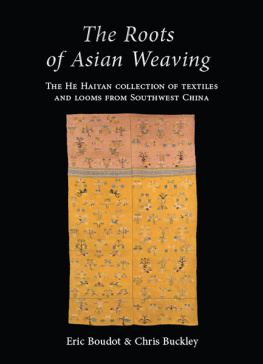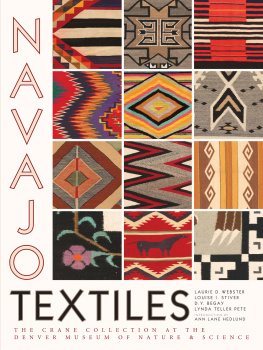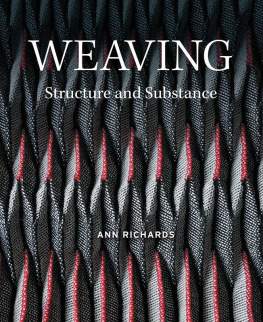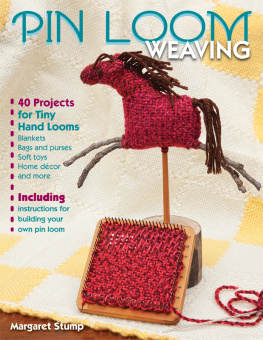Eric Boudot - The Roots of Asian Weaving: The He Haiyan Collection of Textiles and Looms from Southwest China
Here you can read online Eric Boudot - The Roots of Asian Weaving: The He Haiyan Collection of Textiles and Looms from Southwest China full text of the book (entire story) in english for free. Download pdf and epub, get meaning, cover and reviews about this ebook. year: 2015, publisher: Oxbow Books Limited, genre: Home and family. Description of the work, (preface) as well as reviews are available. Best literature library LitArk.com created for fans of good reading and offers a wide selection of genres:
Romance novel
Science fiction
Adventure
Detective
Science
History
Home and family
Prose
Art
Politics
Computer
Non-fiction
Religion
Business
Children
Humor
Choose a favorite category and find really read worthwhile books. Enjoy immersion in the world of imagination, feel the emotions of the characters or learn something new for yourself, make an fascinating discovery.
- Book:The Roots of Asian Weaving: The He Haiyan Collection of Textiles and Looms from Southwest China
- Author:
- Publisher:Oxbow Books Limited
- Genre:
- Year:2015
- Rating:4 / 5
- Favourites:Add to favourites
- Your mark:
- 80
- 1
- 2
- 3
- 4
- 5
The Roots of Asian Weaving: The He Haiyan Collection of Textiles and Looms from Southwest China: summary, description and annotation
We offer to read an annotation, description, summary or preface (depends on what the author of the book "The Roots of Asian Weaving: The He Haiyan Collection of Textiles and Looms from Southwest China" wrote himself). If you haven't found the necessary information about the book — write in the comments, we will try to find it.
Eric Boudot: author's other books
Who wrote The Roots of Asian Weaving: The He Haiyan Collection of Textiles and Looms from Southwest China? Find out the surname, the name of the author of the book and a list of all author's works by series.
The Roots of Asian Weaving: The He Haiyan Collection of Textiles and Looms from Southwest China — read online for free the complete book (whole text) full work
Below is the text of the book, divided by pages. System saving the place of the last page read, allows you to conveniently read the book "The Roots of Asian Weaving: The He Haiyan Collection of Textiles and Looms from Southwest China" online for free, without having to search again every time where you left off. Put a bookmark, and you can go to the page where you finished reading at any time.
Font size:
Interval:
Bookmark:
Published in the United Kingdom in 2015 by
OXBOW BOOKS
10 Hythe Bridge Street, Oxford OX1 2EW
and in the United States by
OXBOW BOOKS
908 Darby Road, Havertown, PA 19083
Oxbow Books and the individual authors 2015
Hardcover Edition: ISBN 978-1-78570-144-3
Digital Edition: ISBN 978-1-78570-145-0
PDF Edition: ISBN 978-1-78570-147-4
Kindle Edition: ISBN 978-1-78570-146-7
A CIP record for this book is available from the British Library
Library of Congress Cataloging-in-Publication Data
Boudot, Eric, author.
The roots of Asian weaving : the He Haiyan collection of textiles and looms from Southwest China / Eric Boudot & Chris Buckley.
pages cm
Includes bibliographical references and index.
ISBN 978-1-78570-144-3 (hardback) -- ISBN 978-1-78570-145-0 (epub) -- ISBN 978-1-78570-146-7 (mobi) -- ISBN 978-1-78570-147-4 (pdf) 1. Textile fabrics--China, Southwest--Catalogs. 2. Looms--China, Southwest--Catalogs. 3. He, Haiyan (Art collector)--Art collections--Catalogs. 4. Textile fabrics--Private collections--China--Catalogs. 5. Looms--Private collections--China--Catalogs. I. Buckley, Chris, author. II. Title.
NK8883.A3S683 2015
746.09513074--dc23
2015027835
All rights reserved. No part of this book may be reproduced or transmitted in any form or by any means, electronic or mechanical including photocopying, recording or by any information storage and retrieval system, without permission from the publisher in writing.
Printed in China
For a complete list of Oxbow titles, please contact:
UNITED KINGDOM
Oxbow Books
Telephone (01865) 241249, Fax (01865) 794449
Email:
www.oxbowbooks.com
UNITED STATES OF AMERICA
Oxbow Books
Telephone (800) 791-9354, Fax (610) 853-9146
Email:
www.casemateacademic.com/oxbow
Oxbow Books is part of the Casemate Group
Contents
by He Haiyan
Hand insertion of supplementary wefts
Hand insertion of supplementary wefts aided by tubes & layers
Acknowledgements
The Authors would like to thank the weavers of Southwest China and Hainan, who have patiently answered our questions, demonstrated their weaving techniques and shown us hospitality. Our main contributors are named in the fieldwork sections of this book. We had many memorable experiences and we hope that they gained something too. We also hope they will feel that this book represents a fair attempt at recording the complexities of their art.
We thank Don J Cohn, noted Sinologist and textile expert, who read and commented on the majority of this book, on a voluntary basis. His comments helped us to avoid a great many pitfalls for the unwary and have made this book immeasurably better. We also thank Oxbow books for perceiving value in our work and for agreeing to publish it as part of their Ancient Textiles series, and Farhad Adineh for his valuable help with the layout.
EB: I would first like to thank my wife Li Fang for her patience, and for sharing with me her deep understanding and knowledge of textiles and peoples during all these years of research and writing, as well as my daughter Violette for her inspiring enthusiasm and joy, and my parents and grandparents for instilling a love of learning from an early age.
I feel most indebted to Michel Gelenine who, while acting French Consul in Guangzhou in the 1980s, was at the origin of my decision to explore and study ethnic textiles in Southwest China, and to Donald Dinwiddie who gave me the confidence and the opportunity to publish my first article on the subject in Orientations magazine in 1994, and who has supported my writing projects ever since. I am very grateful to Marie-Helene Guelton who, as Director of Textile Analysis at the Lyons textile Museum, generously shared her passion for, and eminent knowledge of the intricate inner structure of weavings. Thanks to Farhad for his precious help with the layout.
I also would like to thank Pr. Yang Wenbing, one of the leading specialists in Miao textiles and dyes in Guizhou, for his continuous help and support; Yang Tongheng, who, as a dedicated driver and assistant for several years, made the field research and the loom collection a success. I thank Chris Hall for his constant encouragement and backing, as well as Dr Alain Thote whose enthusiasm for the book concept has been inspiring from the early stages of the project. My most grateful thanks go to He Haiyan, passionate textile creator and collector from Beijing, without whom this book would never have been accomplished. And Chris Buckley whose patience, perseverance, scientific approach and enlightened vision allowed this book to become what it is.
CB: my thanks to Cai Yu Liang and the weavers at Donghezhen and Wuzhishan on Hainan for their time and enthusiasm. I would also like to thank Susan Stem, Deb Swingholm, Pamela Cross, Gina Corrigan and Deb McClintock for sharing information on weaving traditions in North Thailand and Vietnam, which provided valuable comparative material for this study. I also thank Steven Frost, my enthusiastic and knowledgeable travelling companion in Guizhou and Yunnan, and Shelagh Reynolds for continuing forbearance and support.
I thank Eric Boudot for friendship and a most interesting and intellectually stimulating partnership: I think Eric feels, as I do, that the product of our collaboration is more than the sum of its parts.
Author Contributions
Introduction and Chapters 13: EB and CB.
Part II: EB (except Hainan: CB).
Part III: CB.
Appendices: EB and CB.
All maps, drawings and photographs are by the authors, except where indicated. Book design and layout by the authors.
Preliminary Notes
Textile terminology
In this book we use the term brocade as a shorthand for textiles decorated with supplementary wefts (continuous and/or discontinuous), and brocading to mean the process of making these textiles. We use this term to describe textile structures, not the materials used. Brocade, under our definition, can be made with any type of fibre (cotton, silk or other) playing the role of warp or weft.
Using these shorthand terms spares us and our readers from repetition of the cumbersome textile decorated with supplementary wefts. Brocade has a variety of alternative meanings (often rather imprecise) in other texts, however. Textile scholar Irene Emery recommended against the use of this term [Emery 1966] and it is not part of the nomenclature recommended by the Centre International dEtude des Textiles Anciens (CIETA). The Chinese term jin , referring to an ancient type of textile, is also translated as brocade in some works. We refer to these textiles as jin or jin brocades.
The variety of textile structures is limitless, and any attempt at a comprehensive and consistent terminology inevitably runs into exceptions and ambiguities. For example, in some cases there is no clear distinction between ground and supplementary wefts. Such terms should be regarded as a first approximation: refer to our detailed analyses of woven structures for a complete description.
Dimensions of textiles are given in centimetres. For bedcovers and other items with borders, the dimensions refer to the main textile, excluding the border, unless otherwise noted.
Regional definitions
For the purposes of this book, our definition of Asia extends from the Indian border in the west to Japan in the east. It includes three sub-regions:
Mainland Southeast Asia (MSEA): Burma, Thailand, Cambodia, Laos, Vietnam and Malaysia
East Asia: China, Japan and Korea
Island Southeast Asia (ISEA): Indonesia, Philippines, East Timor and Papua New Guinea.
Classification of Ethnic Groups
No universal definition of ethnicity exists, and all categorizations must be treated as working definitions. One approach to characterizing ethnicity is to use a cultural marker of some kind. Textiles and styles of dress have sometimes been used in this manner, and many informal names of minority groups in China are based on features of dress and coiffure. The definitions used by most scholars, however, and the ones that we have followed, are based on language and location.
Next pageFont size:
Interval:
Bookmark:
Similar books «The Roots of Asian Weaving: The He Haiyan Collection of Textiles and Looms from Southwest China»
Look at similar books to The Roots of Asian Weaving: The He Haiyan Collection of Textiles and Looms from Southwest China. We have selected literature similar in name and meaning in the hope of providing readers with more options to find new, interesting, not yet read works.
Discussion, reviews of the book The Roots of Asian Weaving: The He Haiyan Collection of Textiles and Looms from Southwest China and just readers' own opinions. Leave your comments, write what you think about the work, its meaning or the main characters. Specify what exactly you liked and what you didn't like, and why you think so.







